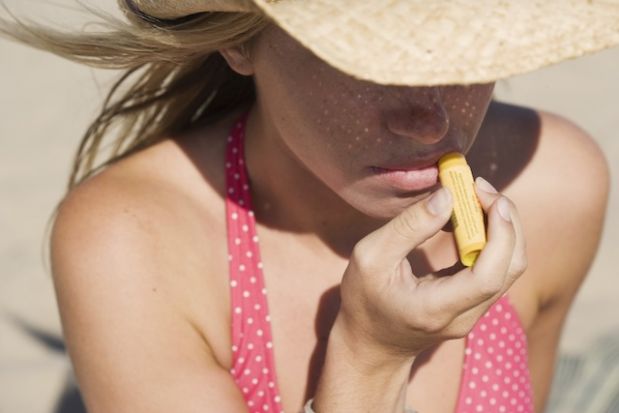Sun Screen Care for Protecting Lips
Dry lips can be caused by many things like dry air, low humidity, drying skin care products, sunburns, dehydration and cold temperatures including cold wind. To prevent your lips from being damaged by the sun and cold winds, creating a barrier on the skin to help protect the delicate area will help prevent dryness. Sunscreen is an excellent source for preventing the lips from becoming sunburned and wind burnt. Apply liberally and keep those puckers hydrated by applying vasoline and coconut oil.
Sunscreen (also known as sunblock, suncream, suntan lotion) is a lotion, spray or other topical product that helps protect the skin from the sun’s ultraviolet radiation, and which reduces sunburn and other skin damage, ultimately leading to a lower risk of skin cancer.
The best sunscreens protect against both UVB (ultraviolet radiation with wavelength between 290 and 320 nanometres), which can cause sunburn, and UVA (between 320 and 400 nanometres), which damages the skin with more long-term effects, such as premature skin aging. Most sunscreens work by containing either an organic chemical compound that absorbs ultraviolet light (such as oxybenzone) or an opaque material that reflects light (such as titanium dioxide, zinc oxide), or a combination of both. Typically, absorptive materials are referred to as chemical blocks, whereas opaque materials are mineral or physical blocks.
Many people apply sunscreen when participating in outdoor activities during the summer. However, experts suggest wearing sunscreen throughout the year to prevent cumulative damage from UVA rays, which are prevalent throughout the year, and to lower the risk of skin cancer. It is recommended that sunscreen be applied 30 minutes before exposure to the sun. Sunblock and sunscreen should also be used as just one form of protection from the sun. Care should be taken to always avoid the sun between the hours of 10 and 2, when the sun’s rays are the strongest; it is also notable that some experts suggest between 10 and 4. Protective clothing, such as wide-brimmed hats, UV 400 sunglasses, and tightly woven clothes with long sleeves and long pants should be worn. Because about 50 percent of the sun’s rays can stream through windows, including those in the car, some dermatologists and skin experts have a UV shield applied to their car windows, which can shield as much as 99 percent of the sun’s harmful rays. Sunscreen should therefore be considered only one defense against the sun, and used in conjunction with other methods.
Dosing for sunscreen can be calculated using the formula for body surface area and subsequently subtracting the area covered by clothing. The dose used in FDA sunscreen testing is 2 mg/cm². From a sample calculation in a FDA monograph, if one assumes an “average” adult build of height 5’4″ (163 cm) and weight 150 lb (68 kg) with a 32″ (82 cm)-waist, that adult wearing a bathing suit covering the groin area should apply 29 grams (approximately 1 oz) evenly to the uncovered body area.
A significant reduction in sun exposure inhibits the production of vitamin D. Though excessive sun exposure has been conclusively linked to some forms of skin cancer and signs of premature aging, there is some evidence that vitamin D may help prevent other forms of cancer. Season, geographic latitude, time of day, cloud cover, smog, skin type, and sunscreen all have an effect on vitamin D production in the skin, but fifteen minutes per day of direct exposure to the sun is a generally accepted guideline to follow for optimum vitamin D production. Experts generally recommend taking a fifteen minute walk in the morning or evening without wearing sunscreen to meet this requirement.
Sun Facts
- Snow, sand, water, concrete and glass reflect sunlight
- Clouds do not protect you from the damaging UV rays.
- The higher the altitude the more intense the sun (6% every 1000 ft)
- The sun damages your eyes, increasing the risk of cataracts, macular degeneration, and eyelid cancers.
- The sun’s UV rays can penetrate many types of clothing
- Dry, dehydrated skin burns more easily than well hydrated skin.
Sun Tips
- Protect newborns from the sun
- Wear a hat to protect your scalp
- Apply sunblock to your ears
- Use non- toxic mineral sunblocks
- Use a self tanner to achieve the desired tan look
- Do not use Rentin-A when you are planning on spending time in the sun.
More tips
- Physical Blocks vs. Chemical Blocks
- Physical Blocks reflect light from your skin whereas Chemical Blocks absorb the sun rays and destroy UV light for a limited time. It is important to always reapply sunscreen
- Use Sunscreen
- Apply sunscreen everyday. If you have an SPF 30, you have approximately 30 minutes of protection plus the time it would take you to burn with out sunscreen…ex. 15 minutes. You would then have approximately 45 minutes of protection.
Tans are not healthy
Not only are you decreasing the collagen thickness of your skin, but the chances of obtaining skin cancer are very high. Refrain from sun exposure whenever possible. There are many types of self tanners on the market that are organic and provide healthy colors.
Avoid Peak Heat
Avoiding direct sunlight between the hours of 10 am. and 3pm. These times provide the suns most dangerous rays. Wear a hat, stand in the shade and avoid the intense heat whenever possible. Staying hydrated with pure water.
More tips
- Choose a sunscreen that blocks both UVA and UVB rays. Look for the words “broad spectum protection” or UVA protection in addition to the SPF of 15 or greater. Select a sunscreen that says “nonacnegenic” or “noncomedogenic” on the label to help keep pores clear.
- We all know that the sun can damage skin, but did you know it can contribute to eye problems, too? Protect your face and eyes with a hat and sunglasses that provide 100% UV protection.
- Some medications, such as prescription acne medications or birth control pills, can increase your sensitivity to the sun, so if you’re taking medication, increase your sun protection.





